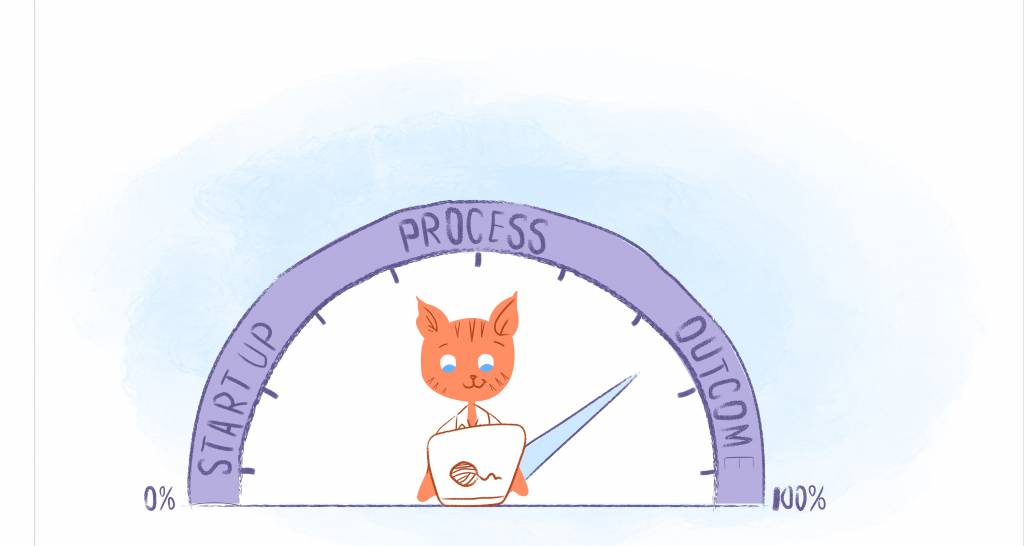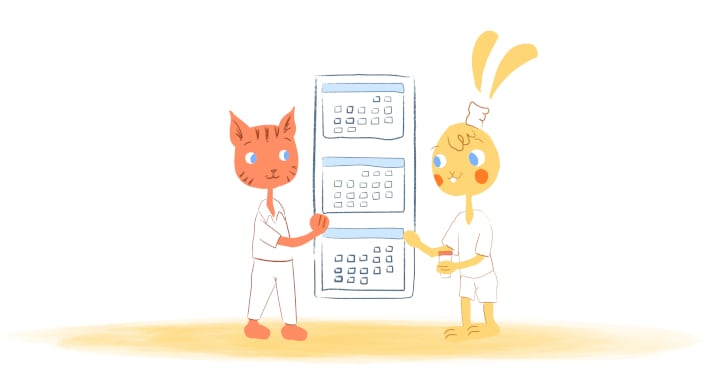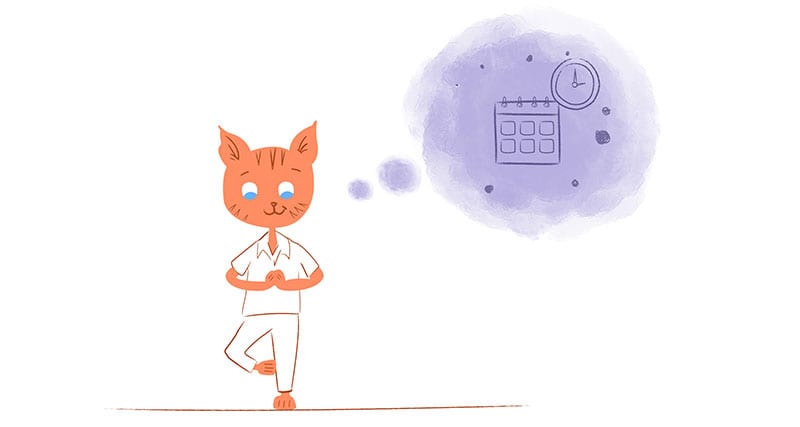

Have you ever been in awe at the people who are happier and more productive than you are? It’s not that they have some superpower to work at faster speeds. It’s usually because they know how to manage their calendars and time better. In some way, they have learned how to get more done in less time. As a result, they get to enjoy life — like spending time with their family and friends or going on some sort of adventure.
Thankfully, these calendar management hacks can you help you work less and play more.
If that’s something that you would be interested in achieving yourself, then try out these following 20 calendar hacks that can help you work less and play more.
1. Run a time audit.
A time audit simply allows you to see where your time goes. This should be the first thing you do before any other tip or trick. After all, if you don’t identify the time drains during your days, then how can you expect to improve your time management?
To run a time audit, just follow these 5 simple steps:
- Jot down your intentions from last month. These are usually your three to five of your biggest priorities and the time you intended to spend on them.
- Use a tool like calendar analytics to see how you actually spent your time. Calendar Analytics runs in the background of your computer and tracks the time you spent working or goofing around on social media.
- Set goals and targets to get your intentions and allocations aligned.
- Adjust your schedule based on your goals, productivity, and time research. For example, if you notice that you’re not as productive in the afternoon, then you should focus on less demanding work.
- Block out time for meetings, calls, breaks, and interruptions.
2. Eat that damn frog.
“Mark Twain once said that if the first thing you do each morning is to eat a live frog, you can go through the day with the satisfaction of knowing that that is probably the worse things that is going to happen to you all day long,” writes Brian Tracy.
What exactly is your “frog?”
Tracy explains that it’s “your biggest, most important task, the one you are most likely to procrastinate on if you don’t do something about it.” If you have two frogs, Tracy recommends that you “start with the biggest, hardest, and most important task first.”
Do the task you hate, first.
Think about this way. If you start your day by knocking out that task you’ve been dreading, then it’s done and over with. Not only do you feel accomplished, you no longer have it lingering in your head, which means you can focus on other tasks.
What’s more, science has found that most adults perform cognitive work best in the late morning. This is because our body temperature continues to rise, alertness, concentration, and working memory improve.
3. Always prioritize.
“This may sound like an obvious one. Truth is, very few people actually know how to prioritize their days,” writes entrepreneur Renzo Costarella.
“On a very basic level, you should prioritize tasks based on urgency. One way to do that is by using the quadrant system that was made popular by Stephen Covey.”
Originally based on Dwight D. Eisenhower’s Decision Principle, this is where you create a square matrix containing four boxes:
1) Urgent/Important, 2) Not Urgent/Important, 3) Urgent/Not Important, and 4) Not Urgent/Not Important.
Try the quadrant matrix for time management.
“This simple matrix allows you to clearly define which tasks should be completed before others,” adds Renzo, “Since we live very dynamic lives the tasks will often change daily. That said, it’s best to plan for tomorrow at the end of your workday today.”
4. Plan a week in advance.
I know that you would rather be spending your Sundays watching football, hiking, or shopping. But, if you take the time to plan your week every Sunday, you’ll realize that it will run much smoother.
This isn’t all that far-fetched. Instead of walking into the office on Monday and getting bombarded with emails and questions, on top of aimlessly wondering what to work on first, you have a game plan.
Can your tasks be broken into a weekly plan?
Start by breaking your weekly goals into manageable daily tasks based around your energy levels and what else is planned for the week. For example, if you have meetings on Tuesday, then you’re probably not going to have the time or energy to eat many frogs. In this case, you would then spend the time in-between meetings doing less challenging tasks, like administrative work.
I also use Sundays to lay out my clothes and prep my meals for the week. This way I’m not wasting valuable time every morning scrambling to pick-out a wardrobe or make my lunch.
5. Use a scheduling app.
There’s no shortage of apps out there that you can use to assist you with managing your calendar and time. However, in my opinion, if there is one app that you need to download it’s a scheduling app.
See, you already have a calendar app in your phone, such as a Google or Apple Calendar. And, although I have nothing against them, nothing beats actually jotting down your lists and crossing them off.
A scheduling app, however, eliminates those back-and-forth communications when trying to set-up a meeting or event. Just share your ability with others and then pick a free scheduling events that works for them. The event is then added automatically to everyone’s calendar.
What’s more, scheduling apps like Calendar can harness the power of machine learning meaning that it can make smart suggestions on when, where, and what type of meeting to schedule.
6. Follow the Rule of 52 and 17.
It’s been found that the most productive people work for 52 minutes and then break for 17 minutes.
This management tool is effective for a couple of reasons:
For starters, when you work for shorter periods of time, you work with a purpose. It’s like sprinting towards the finish line in a race. During those 52 minutes, you’re only focused on accomplishing tasks and getting stuff done.
Secondly, after working in sprints, you need the time to catch your breath. Our brains weren’t meant to work non-stop. We get exhausted and bored. Taking a break every hour or so gives our brains to rest and recharge.
7. Quit your addiction to email.
Most of us send and receive hundreds of emails per day. Suffice to say, checking your inbox every time you receive a notification can become a problem.
As Daniel J. Levitin, a professor at McGill University, wrote in The New York Times, “An email that you know is sitting there, unread, may sap attentional resources as your brain keeps thinking about it, distracting you from what you’re doing. What might be in it? Who’s it from? Is it good news or bad news? It’s better to leave your email program off than to hear that constant ping and know that you’re ignoring messages.”
So, what’s the solution? Here are a couple of tricks you can try to ease your email addiction:
- Disable push notifications.
- Turn your email off altogether.
- Block out specific times throughout the day to check your email.
- Install email management apps like Astro and Unroll.me.
8. Make sure meetings have a purpose.
Meetings are arguably the biggest time-waster in businesses. Before scheduling or accepting any type of meeting, make sure that there’s a clear purpose. If not, you may be able to skip the meeting and handle the situation through a conference call, email, or through your project management software.
If you must schedule a meeting, send out an agenda prior to the meeting, limit the number of people you invite, and keep it short and concise. You should also try outstanding meetings since they can cut meeting times by 25%.
9. Stop multitasking.
Multitasking isn’t just overrated, it’s ineffective and counterproductive.
“When it comes to attention and productivity, our brains have a finite amount,” says Guy Winch, Ph.D., author of Emotional First Aid: Practical Strategies for Treating Failure, Rejection, Guilt and Other Everyday Psychological Injuries.
“It’s like a pie chart, and whatever we’re working on is going to take up the majority of that pie. There’s not a lot left over for other things, with the exception of automatic behaviors like walking or chewing gum.” In fact, switching between several tasks wastes productivity because your attention is working on the act of switching gears. And, you never fully get “in the zone” for either activity.
Eliminate the distractions around you and work on only one thing at a time.
10. Kill two birds with one stone.
There’s a pretty concept called “half-time.” Does this mean thinking about the ways that you can spend time doing something while getting double the results?
One example, from Max Palmer, is cooking a meal.
Max suggests that you “make twice the amount you normally do and freeze the rest for later. You effectively saved yourself 30-minutes to an hour of cooking and cleaning time by using this method.”
11. Set a time limit on tasks.
This almost makes a game out of your daily tasks. For instance, you could set a timer for 15-minutes to see how many emails you could respond to or how many dishes you can wash. For me, I set an hour timer to see how much of an article I can write.
Competing against yourself can be a great motivator to work faster.
12. Eliminate decision fatigue.
Did you ever wonder why Steve Jobs and Mark Zuckerberg were known for wearing the same outfits over and over again? It wasn’t just to brand themselves. It was to prevent decision fatigue.
Jory MacKay notes that after “analyzing over 225 million hours of working time in 2017,” the RescueTime team “found the average user switches between tasks more than 300 times per day (and this was only during working hours!)”
“Not only does this level of context switching pick apart our focus, but each of those decisions to switch tasks eats into our willpower a little bit. Eventually, we hit what’s called decision fatigue: Where our lack of energy and focus leads to making poor decisions,” explains MacKay.
To prevent this from becoming a problem, here’s a couple of ways that you can reserve your mental energy:
- Simplify the choices you have to make throughout the day. For instance, lay out your clothes for the week and prep your meals.
- Limit your daily to-do-lists to under 5 items.
- Just get started. The Zeigarnik effect explains that when starting a task, your brain becomes obsessed with it until it’s finished.
- Again, work on your most important tasks or priorities when you have the most energy and willpower.
- Take an afternoon nap. MacKay explains that when we “sleep, our brain prunes away some of the connections between neurons, making room for whatever new information we’ll come across when we wake up.”
13. Work from somewhere else.
I work from home. I love it. No commute and few distractions. However, it can get monotonous and a little to quiet. When I’m dragging, there’s no one around to motivate me.
I also know people who work in office who experience the opposite. They have a lengthy commute and are surrounded by a lot of noise — not to mention that coworker who keeps pestering them.
The solution to both could be occasionally working from somewhere else, such as a coffee shop, park bench, or coworking space. Besides being quiet, they can also motivate you to work since you’re surrounded by other people who are cranking out work.
14. Make the most of waiting.
Whether if it’s waiting in lines at the grocery store or to catch the subway or waiting rooms and airport terminals, we all spend a lot of time waiting. Instead of just sitting there, use that wisely by cleaning out your inbox, listening to podcasts, reading, or even doing a little stretching and meditation.
15. Crank up the tunes.
Listening to your favorite music gets those creative juices flowing. It can also make you more efficient.
One study found that when surgeons listened to music while working, they increased their speed and accuracy. If you know which songs can motivate you, create a playlist on an app like Spotify, and listen to it when it’s time crank out some work.
Additionally, classical, instrumental, and ‘feel’ good music have also been found to help boost productivity. If that’s not your cup of tea, you can try out video game soundtracks or the tried and true sounds of nature.
Just make sure that it’s not too loud since that can be distracting.
16. Delegate or outsource.
Check your ego at the door and admit that you can’t do everything by yourself. I mean what’s the point of being your own bookkeeper or social media manager when you have bigger fish to fry, like growing or improving your business or spending quality time with your family.
Hand-off tedious tasks to someone else — or do them all quickly in succession.
Instead of spending your time on this less important and tedious tasks, hand them over to someone else. Maybe it’s delegating your social media efforts to a team member who loves interacting with people on social channels. If you don’t have anyone in-house, you could outsource these tasks to freelancers.
17. Stop being a perfectionist.
“Many of us struggle with the idea that we always need to be perfect. Whether it’s a simple sales proposal or an investor presentation we’re always trying to make it better,” writes Angela Ruth in a previous Calendar article. “The truth is, there’s a point where it’s good enough and any extra effort is a waste of time.”
Keep your eye on a bigger picture.
“Is the investor really going to care what font you use? Do you think they’ll invest based on the images you used on your marketing slide? The answer is usually no, and it’s important to recognize this no matter what you’re putting together.”
So, stop sweating the small stuff, do your best, and move on to something else.
18. Leave blank spaces in your calendar.
Take a look at your calendar. Is it jam-packed so much that you just feel like you’re doing something non-stop? If so, you’ll eventually become overcommitted, overwhelmed, and burned out to a crisp.
To prevent this from happening, you should start adding blank spaces in your calendar.
Author Greg McKeown writes about this in his New York Times best-selling book Essentialism. He says, “The faster and busier things get, the more we need to build thinking time into our schedule. And the noisier things get, the more we need to build quiet reflection spaces in which we can truly focus.”
When will your two hours of uninterrupted time be?
Jeff Weiner, CEO of LinkedIn, is known for blocking out up to two hours per day for uninterrupted time to do nothing. This allows him to process what’s going on and do his job more effectively.
Don’t think you have the tie? McKeown says, “No matter how busy you think you are, you can carve time and space to think out of your workday.” Instead of jumping on your phone first thing in the morning or checking social media during your afternoon slump, you use those times to reflect.
19. Keep a “done list.”
You probably noticed that I didn’t include having a to-do-list here. While they can be useful, they can often be counterproductive. They’re either so lengthy that we don’t get to everything on them and they focus on what to next. Since research shows that having a sense of progress is the most influential factor in motivation, creativity, and positivity in regards to work, this shouldn’t be ignored.
As such, it’s suggested that you keep a “done list” in addition to your to-do-list. This is simply a log of all of the tasks that you’ve completed. When see everything that you’ve accomplished, it will inspire you to keep at it.
Here’s how you can get started on your time practice:
- Take 10-minutes every Friday to write down your wins for the week.
- Have a separate “done” list for each project that you’re working on.
- If working with a team, encourage them to discuss the progress that they’ve made. They can do this using project management software so that you don’t have to call a meeting.
20. Own your calendar, before it owns you.
“Calendar management is the single most important thing, especially as you get busy and have more responsibilities,” Mary Callahan Erdoes,, the CEO of JPMorgan Asset Management, told CNBC.
“You have to be maniacally focused on owning your calendar, on having the lists of what you need from other people and what other people need from you. What are the short-term issues that need to be dealt with? What are the long-term issues?
“Unless you can stay on top of that religiously, [time, calendar] it will end up owning you, and that’s not a way to go about staying organized and being on top of things.”
There are a actually a couple of ways to achieve this. For starters, learn how to set boundaries and say “no.” For example, when you set working hours, let others know — the easiest way to do this is by sharing your calendar. This way you can focus on your priorities during that time.
You don’t have to be rude about your time — but you can be firm.
This also means having “off-hours.” When you’re home having dinner with your family or going away for the weekend with your friends there is no working allowed. That’s your time to unplug, decompress, recharge, and enjoy yourself.
Keep it clean…
Also, keep your calendar free from clutter. This prevents your calendar from getting so full that it becomes impossible to manage and organize. For instance, go through and review all of your recurring events and commitments. You may have outgrown these and now they’re a burden that’s vying for your time.











John Rampton
John’s goal in life is to make people’s lives much more productive. Upping productivity allows us to spend more time doing the things we enjoy most. John was recently recognized by Entrepreneur Magazine as being one of the top marketers in the World. John is co-founder of Calendar.